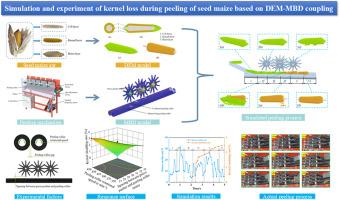Simulation and experiment of kernel loss during peeling of seed maize based on DEM-MBD coupling
IF 5.3
1区 农林科学
Q1 AGRICULTURAL ENGINEERING
引用次数: 0
Abstract
To address the issue of significant kernel loss during the peeling process of seed maize, this study constructs a discrete element model (DEM) of seed maize ear aggregates based on the three-layer structure of the maize ear through hierarchical modelling and the particle filling method. At the same time, a multi-body dynamics (MBD) model of the peeling mechanism is created using the mesh delineation and flexible body method. The DEM-MBD coupling method is employed to simulate the interaction process between the seed maize and the peeling mechanism, analysing the impact of different working parameters of the peeling mechanism on the loss of maize kernels. Using the principle of the Box-Behnken experimental design, a three-factor, three-level experiment is carried out. Based on the experimental results, a quadratic polynomial regression model between the experimental factors and the indicator is established. Through multi-objective optimisation and experimental verification, the optimal combination of working parameters for the seed maize peeling mechanism is obtained: the spacing between the press-pusher and the peeling roller is 33 mm, the peeling roller rotational speed is 420 r·min−1, and the peeling roller gap is - 0.8 mm, with the kernel shedding rate being 0.80 %. The error between the simulation and verification experimental results is <3 %, validating the accuracy and reliability of the simulation model in predicting kernel loss. The peeling rollers used in the experiment meet the performance requirements for seed maize peeling, and the method adopted can offer some reference for the improvement and parameter optimisation of the seed maize peeling mechanism.

基于DEM-MBD耦合的种子玉米脱皮过程籽粒损失模拟与试验
为解决玉米种子剥皮过程中籽粒流失严重的问题,本研究基于玉米穗的三层结构,通过分层建模和粒子填充法构建玉米种子穗团聚体离散元模型(DEM)。同时,采用网格划分和柔体法建立了剥离机构的多体动力学模型。采用DEM-MBD耦合方法模拟玉米籽粒与脱皮机制的相互作用过程,分析脱皮机制不同工作参数对玉米籽粒损失的影响。采用Box-Behnken实验设计原理,进行了三因素、三水平的实验。在实验结果的基础上,建立了实验因素与指标之间的二次多项式回归模型。通过多目标优化和实验验证,得到了种子玉米脱皮机构的最佳工作参数组合:推压机与脱皮辊间距为33 mm,脱皮辊转速为420 r·min−1,脱皮辊间隙为- 0.8 mm,脱粒率为0.80%。仿真结果与验证实验结果误差为3%,验证了仿真模型预测核损失的准确性和可靠性。实验使用的去皮辊满足玉米种子去皮的性能要求,所采用的方法可为玉米种子去皮机理的改进和参数优化提供一定的参考。
本文章由计算机程序翻译,如有差异,请以英文原文为准。
求助全文
约1分钟内获得全文
求助全文
来源期刊

Biosystems Engineering
农林科学-农业工程
CiteScore
10.60
自引率
7.80%
发文量
239
审稿时长
53 days
期刊介绍:
Biosystems Engineering publishes research in engineering and the physical sciences that represent advances in understanding or modelling of the performance of biological systems for sustainable developments in land use and the environment, agriculture and amenity, bioproduction processes and the food chain. The subject matter of the journal reflects the wide range and interdisciplinary nature of research in engineering for biological systems.
 求助内容:
求助内容: 应助结果提醒方式:
应助结果提醒方式:


